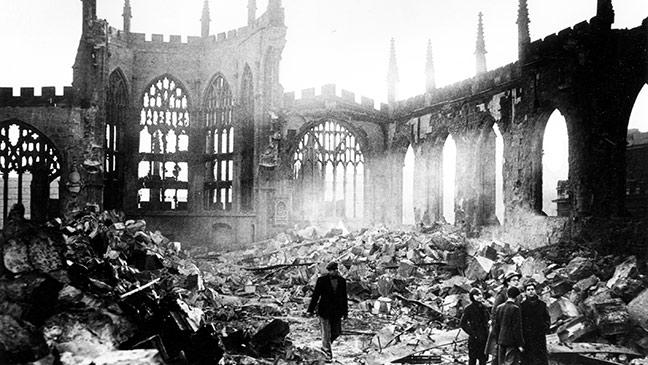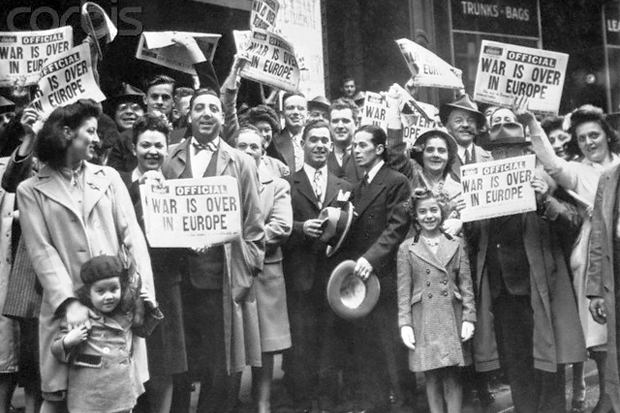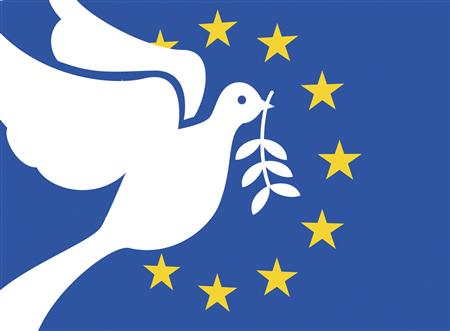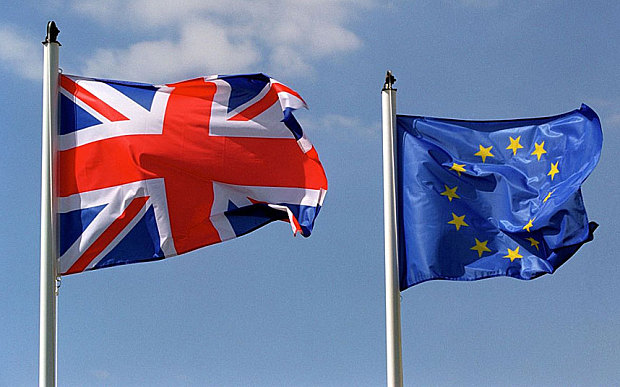My Story is My Witness
"Healing the wounds of history, learning to live with difference and celebrate diversity, and building a culture of peace and justice in the interest of the common good"
This is the Europe that Coventry Story encourages us to believe in

November 14, 1940: the 14th century Coventry Cathedral is destroyed by German bombs
Photo: printerest.com
European Union (EU) is not merely a free-trade area, or just a market place for economic activity, it is a region of the human spirit. It is a place of our moral and spiritual compass to build a better world in the interest of the common good. Like anything else in life, the EU, as an institution, is not perfect. It needs to be improved; and most importantly, rather than retreating from the EU, the best way to avoid further crises would be to reform the European institutions to make them stronger; something that I believe David Cameron to some extent has achieved in his recent negotiations.
I for one, as an engaged British Citizen, living in this globalised world, hugely prefer to be in Europe, rather than outside it. I have come to this conclusion, mainly as a result of “My Coventry Story”, a story beginning with a previous Europe, a Europe of war and destruction, and ending with today’s Europe, a Europe of hope, solidarity, cooperation, integration, and peace.
This is why I firmly believe that the Eurosceptics in Britain, and indeed elsewhere in Europe, should come to Coventry and visit Coventry Cathedral, to witness the folly, stupidity and inhumanity of war and to reflect and think about the beauty, wisdom and the relevance of Coventry’s message of hope, forgiveness and reconciliation for Europe today.
For me seeing the EU, mainly as a Peace Project, means that we all, as a whole gain more in Europe, as Winston Churchill so eloquently noted in his speech in The Hague in 1948:
“If we all pull together and pool the luck and the comradeship … and firmly grasp the larger hopes of humanity, then it may be that we shall move into a happier sunlit age, when all the little children who are now growing up in this tormented world may find themselves not the victors nor the vanquished in the fleeting triumphs of one country over another in the bloody turmoil of … war, but the heirs of all the treasures of the past and the masters of all the science, the abundance and the glories of the future.”
First a bit of History
I- Europe at War with Itself

Photo: kenbrown.info
As it has been noted, at the end of the First World War it had been possible to contemplate going back to business as usual. However, 1945 was different, so different that it has been called Year Zero. The capacity for destruction had been so much greater than in the earlier war that much of Europe lay in ruins. And this time civilians had been the target as much as the military. The figures are hard to grasp: as many as 60 million dead, whilst new words, genocide, and holocaust entered the language to deal with the utmost inhumanity and barbarism of what the Europeans had done to each other.

Tyne Cot British and Commonwealth War Cemetery at the Belgian city of Ypres
Photo: i.telegraph.co.uk
A common expression after 1945 was “Never again,” which symbolized a universal desire to avoid another world war. The peoples of Europe were especially committed to this ideal after watching their families torn apart and their homes destroyed.
But how could peace in Europe be guaranteed? Many felt that the responsibility for the wars lay with nationalism in Europe. The great powers in Europe, the United Kingdom, France, Germany, and Russia competed fiercely with each other even in peacetime for economic and military dominance. Tariffs and other barriers to trade were established between most European countries. For many observers, including politicians, intellectuals, and members of resistance movements, the answer became clear: Europe must be integrated. Instead of competition between European states, there was a need for a system of co-operation.(EU Learning: carleton.ca)
II- Staying in the EU isn’t just about Britain’s prosperity
"As Britain moves slowly but surely toward an in/out referendum on membership in the European Union, it appears likely that both sides in this debate will centre their arguments on economic issues, specifically on whether Britain would be better off inside or outside the EU framework. Supporters of the continuation of Britain’s membership will cite the increased economic clout and stable trade framework that the EU generates for the United Kingdom. Although these arguments will need to form an integral part of the “Yes” campaign’s argumentation, it would be a grave mistake to focus on economic issues alone.
Recent referenda have demonstrated the dangers of giving the mind too privileged a status over the heart. In the Scottish independence referendum, the Better Together campaign zeroed in on the currency file, claiming that an independent Scotland would not be able to retain the pound. This provided the “Yes” side with a monopoly over the emotional argument. As a result, the outcome of the referendum was much closer than most observers had initially expected.
The 1995 sovereignty referendum in Quebec demonstrated a similar tendency. The “Non” campaign spent far too much time discussing the economic non-viability of an independent Quebec, thinking that this would be enough to destroy the “Oui” campaign’s prospects. The result was the near-break up of the Canadian federation, with 49.5 percent of voters siding with the sovereigntists.
The lesson here is clear: In the event of a referendum, those fighting for unity cannot afford to cede the emotional terrain to the forces of division. In the upcoming in/out referendum, the “No” side will be certain to pander to the forces of nationalism, claiming implicitly that England can reclaim its past glory without the help of the European Union. The “Yes” side will need a convincing response that goes beyond mere economics.
We believe that one way to achieve this is for the “Yes” campaign to speak not only of prosperity, but also of peace. The EU isn’t merely a vehicle for enhancing trade; it represents an institutional framework that has been vital to the preservation of peace in Europe for decades.
The EU today faces numerous challenges. Although the EU’s financial institutions are once again solvent, the recent standoff between Greece and its creditors shows that Europe’s sovereign debt crisis isn’t completely in the rear-view mirror. Europe’s post-Cold War security framework is broken, as the Ukraine crisis has so clearly demonstrated. And not least, the flow of migrants and refugees into Europe has only added to the crisis of confidence in the EU’s sovereignty pool that has helped to fuel the rise of several anti-EU populist movements.
But this is no reason to throw the baby out with the bathwater. In times of difficulty, we have a responsibility to be constructive. Not only would leaving the EU likely result in the breakup of the United Kingdom, it would also represent a significant blow to an organisation that has helped to keep Europe at peace for so long.
With the utility and purpose of the NATO alliance very much in question over the long term, the European Union will have to assume the mantle of international leadership. Britain has a long history of ensuring an equilibrium in power dynamics on the Old Continent. Today, British initiative and direction within the EU framework could be transformative.
The European Union was never meant to be a mere trading bloc or customs union; the phrase “ever-closer union” in the 1956 Treaty of Rome demonstrates this quite lucidly. Indeed, from the establishment of the European Coal and Steel Community in 1951 to the more recent creation of a common European currency, the EU’s goal has always been a political one: to promote and secure peace in Europe.
The choice for Britain is clear. With a “Yes” vote and renewed British leadership in European affairs, Westminster can secure London’s position as the financial capital of the world’s single largest economy and help to protect the unity of the United Kingdom. But even more importantly, a vote to stay in the EU would be a vote to continue the peace project that has demonstrably transformed Europe for the better over the course of the postwar era. Prosperity is important, but one cannot have prosperity without peace.” (By Vijay Mehta and Zach Paikin, posted on britishinfluence.org on 15 January 2016)

WWii is over. Europe on the road to a new beginning
Photo: eppgroup.eu
III- Europe’s Path to Cooperation and Peace
1945 – 1959: A peaceful Europe – the beginnings of cooperation

Photo: twitter.com
The European Union is set up with the aim of ending the frequent and bloody wars between neighbours, which culminated in the Second World War. As of 1950, the European Coal and Steel Community begins to unite European countries economically and politically in order to secure lasting peace. The six founders are Belgium, France, Germany, Italy, Luxembourg and the Netherlands. The 1950s are dominated by a cold war between east and west. Protests in Hungary against the Communist regime are put down by Soviet tanks in 1956; while the following year, 1957, the Soviet Union takes the lead in the space race, when it launches the first man-made space satellite, Sputnik 1. Also in 1957, the Treaty of Rome creates the European Economic Community (EEC), or ‘Common Market’.
1960 – 1969: The ‘Swinging Sixties’ – a period of economic growth
The 1960s sees the emergence of 'youth culture’, with groups such as The Beatles attracting huge crowds of teenage fans wherever they appear, helping to stimulate a cultural revolution and widening the generation gap. It is a good period for the economy, helped by the fact that EU countries stop charging custom duties when they trade with each other. They also agree joint control over food production, so that everybody now has enough to eat - and soon there is even surplus agricultural produce. May 1968 becomes famous for student riots in Paris, and many changes in society and behaviour become associated with the so-called ‘68 generation’.
1970 – 1979: A growing Community – the first Enlargement
Denmark, Ireland and the United Kingdom join the European Union on 1 January 1973, raising the number of member states to nine. The short, yet brutal, Arab-Israeli war of October 1973 result in an energy crisis and economic problems in Europe. The last right-wing dictatorships in Europe come to an end with the overthrow of the Salazar regime in Portugal in 1974 and the death of General Franco of Spain in 1975. The EU regional policy starts to transfer huge sums to create jobs and infrastructure in poorer areas. The European Parliament increases its influence in EU affairs and in 1979 all citizens can, for the first time, elect their members directly.
1980 – 1989: The changing face of Europe - the fall of the Berlin Wall
The Polish trade union, Solidarność, and its leader Lech Walesa, become household names across Europe and the world following the Gdansk shipyard strikes in the summer of 1980. In 1981, Greece becomes the 10th member of the EU and Spain and Portugal follow five years later. In 1986 the Single European Act is signed. This is a treaty which provides the basis for a vast six-year programme aimed at sorting out the problems with the free-flow of trade across EU borders and thus creates the ‘Single Market’. There is major political upheaval when, on 9 November 1989, the Berlin Wall is pulled down and the border between East and West Germany is opened for the first time in 28 years, this leads to the reunification of Germany when both East and West Germany are united in October 1990.
1990 – 1999: A Europe without frontiers
With the collapse of communism across central and Eastern Europe, Europeans become closer neighbours. In 1993 the Single Market is completed with the 'four freedoms' of: movement of goods, services, people and money. The 1990s is also the decade of two treaties, the ‘Maastricht’ Treaty on European Union in 1993 and the Treaty of Amsterdam in 1999. People are concerned about how to protect the environment and also how Europeans can act together when it comes to security and defence matters. In 1995 the EU gains three more new members, Austria, Finland and Sweden. A small village in Luxembourg gives its name to the ‘Schengen’ agreements that gradually allow people to travel without having their passports checked at the borders. Millions of young people study in other countries with EU support. Communication is made easier as more and more people start using mobile phones and the internet.
2000 – 2009: Further expansion
The euro is the new currency for many Europeans. 11 September 2001 becomes synonymous with the 'War on Terror' after hijacked airliners are flown into buildings in New York and Washington. EU countries begin to work much more closely together to fight crime. The political divisions between east and west Europe are finally declared healed when no fewer than 10 new countries join the EU in 2004, followed by two more in 2007. A financial crisis hits the global economy in September 2008, leading to closer economic cooperation between EU countries. The Treaty of Lisbon is ratified by all EU countries before entering into force on 1 December 2009. It provides the EU with modern institutions and more efficient working methods.
2010 –today: A decade of opportunities and challenges
The new decade starts with a severe economic crisis, but also with the hope that investments in new green and climate-friendly technologies and closer European cooperation will bring lasting growth and welfare. (The history of the European Union: europa.eu)

Britain in and with Europe
Photo: i.telegraph.co.uk
IV- Why Eurosceptics should visit Coventry Cathedral
“Father, Forgive” - these two words which I discovered at the ruins of Coventry Cathedral in 1973 changed the course of my life.
This is the story I must tell.

Coventry Cathedral
Photo: Anne Mofid
'It is 42 years since I first visited Coventry Cathedral. It had a profound impact on me, hugely influencing and inspiring me to be who I am and what I now do.
It was, if I remember rightly, on an early morning in November 1973. A few months earlier, I had met a wonderful girl from Coventry in Oxford, where we were living and studying, a girl who later became my dear wife, Annie. In July 1974 we were married at the old, historical Saint Osburg’s in Coventry.
In November 1973 Annie had invited me to her home town of Coventry, so that she could introduce me to her parents. It was a memorable occasion for me, leading to a long and loving relationship between us, which I cherish dearly.
We visited the cathedral. I can recall it was a cold grey day. I was only 21 years old, and had arrived in England, only a couple of years earlier from Iran, as a student to further my studies. I did not know anything about Coventry, its bombed and destroyed Cathedral, its industrial heritage, and moreover, I did not know much about Christianity, except what I had heard about Jesus and Mary, which in Iran I knew as ”Hazrat-e Isa” and “Maryam-e Moghadas” (Prophet Jesus and Holy Mary).
To cut a long story short, Annie gave me a quick tour of the Cathedral, the old, destroyed one and then took me down the stairs to the new one.
For sure, I didn't understand every word Annie was telling me. Indeed, I suspect I was lost at times but, as I recall, I could not believe what I was seeing and hearing.
Later on, in my search to learn more about what I had seen in Coventry Cathedral on that November day, I discovered:
that in just one night more than 43,000 homes, 71 factories, the entire city centre, two hospitals, two churches and the police station had been destroyed by 449 German bombers, dropping 30,000 incendiary bombs. An estimated 568 people had died in the raid on the first night of bombing, with over one thousand people sustaining serious and life-threatening injuries;
that as a result of their efforts, the Nazis coined the verb Coventrierung (literally, to Coventrate) to describe total annihilation of a city through aerial bombardment;'...
Continue to read:
Coventry and I: The story of a boy from Iran who became a man in Coventry
Read more:
EUROPA - European Union website, the official EU website
EU Learning - Carleton University
Living together harmoniously in Europe
